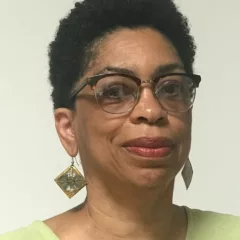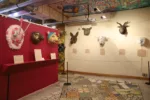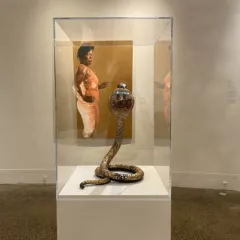With so many exhibits all over the city first for printmaking and then ceramics, the question needs to be asked. How to recognize which well-crafted tree in the forest is the rare specimen worth the visit?
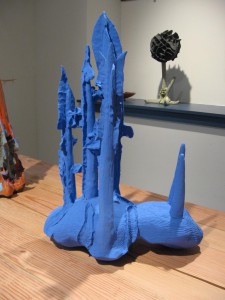
One resounding answer for which ceramics exhibits are worth your time is the exhibit at Fleisher/Ollman, with work by Paul Swenbeck, Annabeth Rosen and Mei-Ling Hom. (I’m sorry the Syd Carpenter at Sande Webster came down so early; it too was pretty amazing–see my Flickr set here).
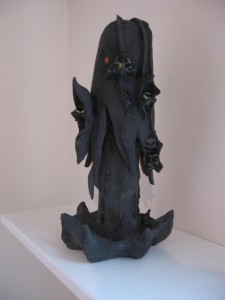
Swenbeck’s table-top sculptures from the Starsprouts series (plus bowls, talismans, and a few wall pieces) belong in a category of their own. They are are black-hearted flowers of evil, alluring with a threatening beauty that attracts as it repels. I wanted to touch them and NOT NOT NOT. Lucas’ death star could take lessons here.
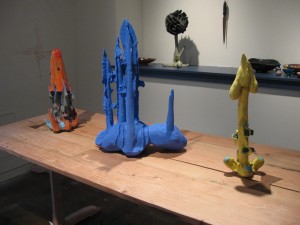
The finishes on these pieces are the anti-luster, the anti-lifeform. These sculptures have a magical quality that speaks to secret and forbidden powers.
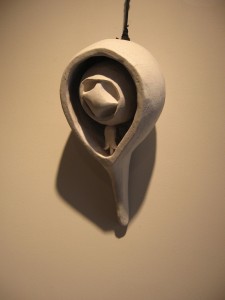
They suggest dangerous, unnatural generative powers. At the same time, they look like they could rest demurely on an end table although I do have to nix them as dining room centerpiece. These pieces are less cartoon-y and therefore more malign than his horror-showish collaborative work with Nick Lenker, up for one more week at Bambi.
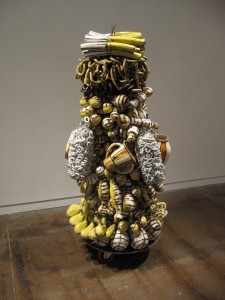
As malign as Swenbeck’s necromancy may be, Annabeth Rosen provides the antidote with her enormous agglomerations of tubes and pretzel shapes on casters. The works, held together with baling wire and netting, suggest colonies of giant tube worms or sea anemones in uncontrolled reproduction and exuberant life forces at work.
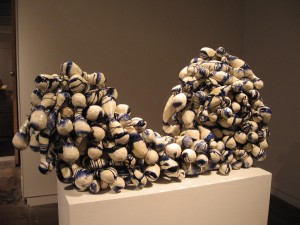
Although the sculptures consist of abundant multiples, the does not come out of the Minimalist multiples tradition. It’s maximalist. Her nature’s factory is not orderly, and the almost barnacle-encrusted forms have a friendly, nearly goofy quality. How can something so pokey and hard look so friendly?
Annabeth Rosen, Romp, with 2-min. animations in collaboration with Jack Friel
The scale of some of these is preteen height–and preteens are pokey and often on human casters–skateboard wheels. And sure enough, one of of the pieces–a depth explosive-looking piece, is covered with little video screens with cartoon skateboarders exploding. The videos are collaborations with a young man–Jack Friel. The cartoons are charming, and the piece gives new context to the rest of this exhibit where the obsessive use of multiples almost pushes it into the outsider category that this gallery often represents. Rosen’s drawings are not quite as strong as the sculptures.
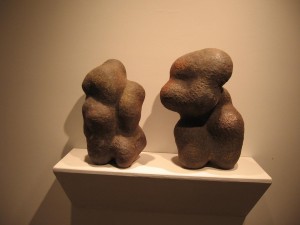
On a very different cloud of her own is Mei-Ling Hom’s continuing engagement with cloud forms, which symbolize good fortune in many Asian cultures. Hom, who has some of her chicken-wire clouds up at Philadelphia airport and had them at the Sackler Gallery in Washington, D.C., is working here in clay. These clouds are challenging. They are heavy, earthly, solid–the antithesis of clouds. But like the real thing, they are also shape shifters, one moment suggesting groups of bear cubs frolicking, then recalling Henry Moore nudes, and the next moment looking like piles of poo.
Back to the issue of festival glut–I’m not sure the participation of the entire city is necessary to create critical mass. What is necessary is quality and a little more focus. There was a lot of substandard work amid the gems. Yet, thanks to NCECA, I got to see this show, and thanks to NCECA, a thousand people a day walked through Fleisher/Ollman–so much traffic the building’s doorman asked what was going on, said gallery Director Amy Adams. I also want to shout out once again the bus tour we took organized by NCECA. It addresses Philadelphia’s biggest on-going problem–how to navigate the city’s spread-out art world. If I were entrepreneurial, maybe I’d start a jitney service.


